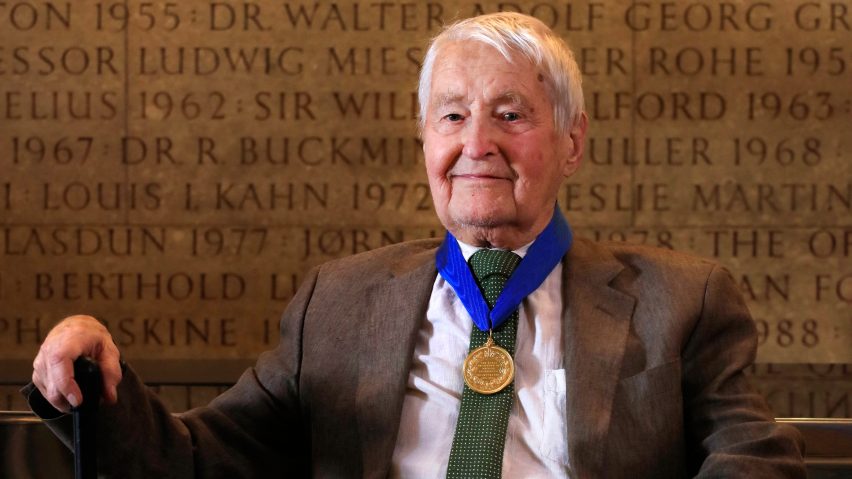
High-rise buildings should only be used to house the very rich, says Neave Brown
Tower blocks like Grenfell should never have been built, according to 2018 Royal Gold Medallist Neave Brown, who believes high-rise housing ostracises council tenants and should instead be reserved for the most wealthy in society.
"Almost all those point blocks and slab blocks should never have been built because they ostracise the underprivileged into special places for the poor, and therefore they become colonies of underprivileged people," Neave Brown told Dezeen.
"In Manchester, Leeds, Liverpool and those big places, the point blocks are centres for delinquency, for children with bad play and for people who are in poverty, unemployed and living desperate lives," he said. "And so they have become centres of social decline, and we all predicted that."
Brown, 88, was this week presented with the RIBA Royal Gold Medal, in recognition of the "quality public housing" he designed in north London.
The architect spoke to Dezeen ahead of the ceremony. The interview took place at his home on the Dunboyne Road Estate, a low-rise housing scheme he designed for the London Borough of Camden in the 1960s.
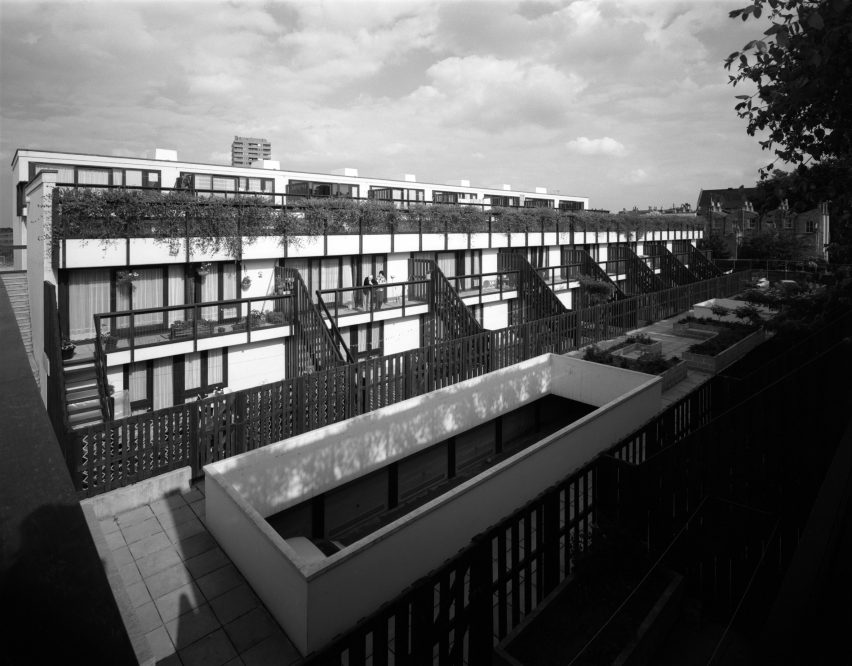
The four-storey-high Dunboyne Road Estate is typical of the architect's post-war housing designs, which are almost exclusively low-rise and high density. His Alexandra Road estate rises to just eight storeys, while his 22-32 Winscombe Street terraces are set over three levels. All of these projects are now listed, in recognition of their architectural value.
Brown says UK has a major problem with its social housing
Brown claims the fatal fire at London's Grenfell Tower this summer highlighted the problems with using high-rise buildings for social housing.
"One single staircase, two slow lifts, 20-storey building, no proper control at entry, people on very low incomes, higher rents than they could afford to pay, borrowing to live in buildings that they didn't like, decline in social patterns, increase of adolescent gangs and destruction. And we predicted all that, we knew it would happen," said Brown.
"High buildings should only be used for the very rich because they're the only ones that can be done with proper lifts, proper services, proper control, proper entrances and the proper environment."
The architect said that sub-standard social housing is "probably England's most massive major social problem".
"The crisis isn't only the Grenfell building, it is masses of other buildings," Brown said, referring to the hundreds of other council-owned high-rises thought to be at risk of fire. "So we have a crisis not only for the people there and those buildings, we have a reassessment crisis of how we should deal with the problem."
"What they're concentrating on is the inquiry into everything that went wrong, and so they should, that needs to inquired into. However, they are doing it and ignoring the big problem, which is how to go ahead and do new housing."
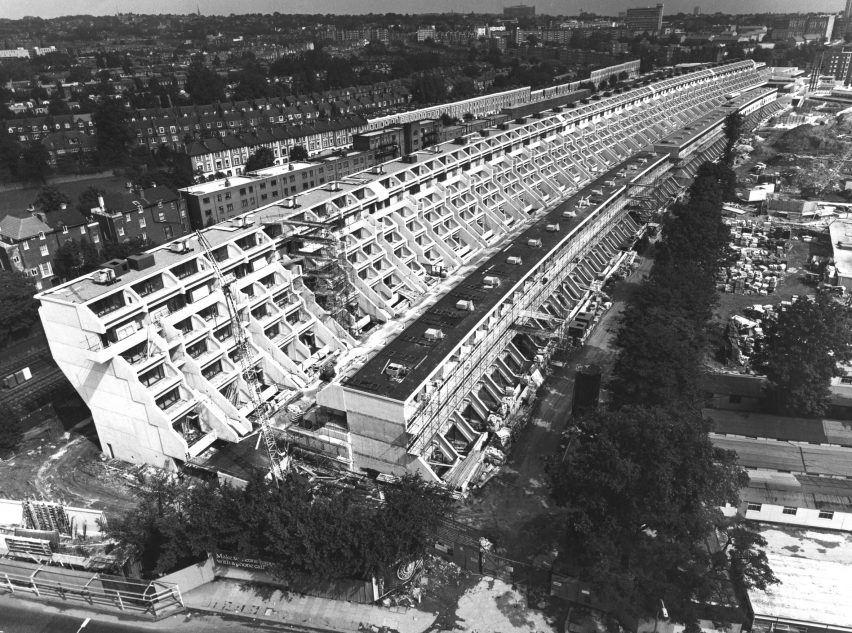
He said that architects and politicians need to stop finger pointing and instead think about developing a new public housing programme – based on the Better Homes for Today and Tomorrow scheme severed by Margaret Thatcher, following her election as UK prime minister in 1979.
Brown wants to reintroduce space standards for public housing
As a starting point, Brown proposed reinstating the Parker Morris Committee, which introduced the generous minimum space standards that were applied to new housing from the late 1960s onwards. These requirements were ended by the Conservative government in 1980 to reduce costs.
"We have to find a way of restarting housing programmes, and I have simple and simplistic notion," he said.
"Margaret Thatcher stopped it all, she stopped what we were doing with Parker Morris, what they called Better Homes for Today and Tomorrow," he continued. "So my first piece of advice would be that we have available there a model that we could revise."
"So alongside the new programme to start social housing again as quickly as possible and to revise the needs with my new committee, we then need a long-term financing system for every single council building that we do."
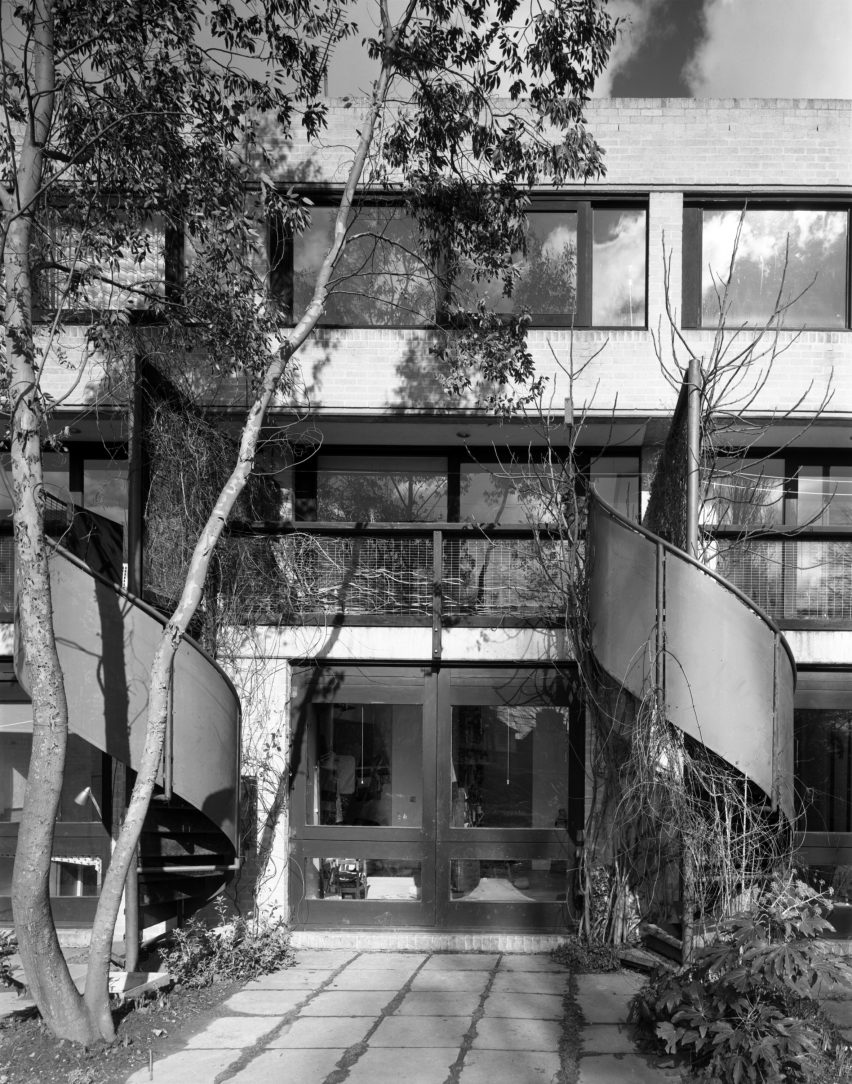
He advised the UK to base its funding model on that of the Netherlands, where buildings are properly maintained for their whole life period by the councils that build them.
The Netherlands could offer better funding model for social housing
"We have to deal with the problem as a social problem, because it can't be dealt with by private money," Brown said. "Private money is in it for profit and profit only, short-term profit only, and not for long-term social problems including tenant control, maintenance and so forth."
"We cannot do social housing or housing for low-income people, urban housing, we cannot do it as private enterprise. It simply can't be done. And that becomes a massive major political conflict," he added.
"We have to face it as a social problem, not as an economic problem for neoliberalism to make money out of. And if we go on doing that, we are going into a future of catastrophe with our eyes wide open."
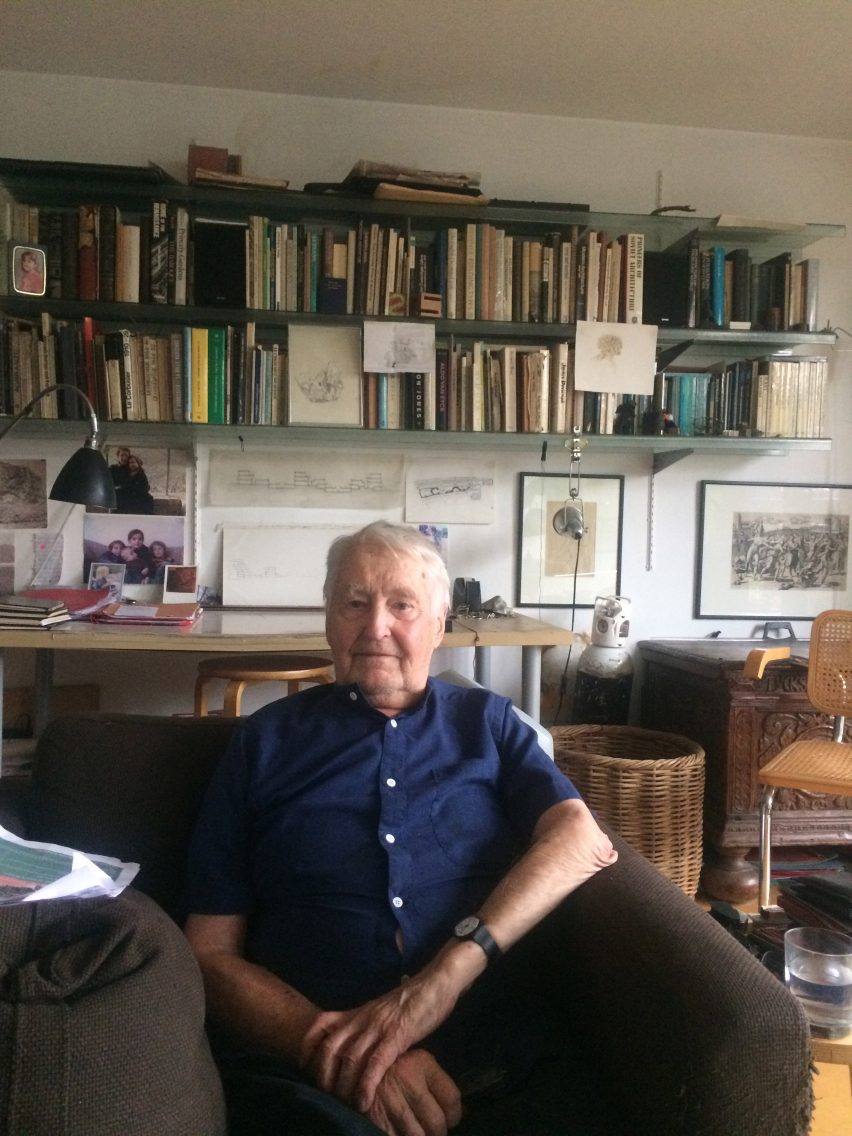
Brown worked on several housing schemes in the Netherlands. He claims he was forced out of work in the UK, as the result of a public inquiry into cost overruns on the Alexandra Road estate.
Following the completion of a development in Eindhoven – the Medina complex, completed in 2002 – Brown stopped practicing as an architect altogether. After that, he devoted himself to fine art, following completion of a bachelors degree at the City and Guilds of London School of Art.
"I literally, not as a denial, just stopped being an architect," he told Dezeen. "I involved myself in my art."
He claimed he was shocked to be awarded the Royal Gold Medal, as he felt his type of architecture had become a thing of the past.
"What I didn't realise was how attractive and interesting it was to students and young people, how it continued in the minds of people, how it was discussed and talked about in schools," he said.
"To me it had just become to my great sadness, simply a piece in the past. And I was, in that sense, dumbfounded and amazed when I heard that I had been put up for the Royal Gold Medal."
Read an edited version of the interview transcript:
Jessica Mairs: Congratulations on winning the Royal Gold Medal, and thank you for inviting me into your home.
Neave Brown: I'm here to hear what you have to say, to say what I have to say, and you'll take it away and do what the hell you want with it!
Jessica Mairs: Wonderful. You've won the medal in part for the social housing you designed in the London Borough of Camden in the 60s and 70s. Post-war housing is very much in the spotlight at the moment but for different reasons.
Neave Brown: It certainly is, because of the situation we have after the fire. I mean it was a bad situation in any case.
People like me from years back have been predicting that there would be terrible consequences from the point blocks and the slab blocks that were being built – that they would create social division, that they would make the poor poorer, that they would make the rich communities around it more difficult, that they were destructive of the society that they were supposed to be serving, and that there would be catastrophes in them.
People like me from years back have been predicting that there would be terrible consequences
One single staircase, two slow lifts, 20-storey building, no proper control at entry, people on very low incomes, higher rents than they could afford to pay, borrowing to live in buildings that they didn't like, decline in social patterns, increase of adolescent gangs and destruction. And we predicted all that, we knew it would happen..
Jessica Mairs: What can we do it resolve these issues?
Neave Brown: It is a catastrophe. I read that there were counted to be 247 point and slab buildings that needed attention and could no longer be properly lived in until they were looked at – and so it is a crisis.
And the crisis isn't only the Grenfell building, it is masses of other buildings. So we have a crisis not only for the people there and those buildings, we have a reassessment crisis of how we should deal with the problem. And we have to deal with the problem as a social problem, because it can't be dealt with by private money.
Private money is in it for profit and profit only, short-term profit only, and not for long-term social problems including tenant control, maintenance and so forth. So we have to find a way of restarting housing programmes, and I have simple and simplistic notion.
Margaret Thatcher stopped it all, she stopped what we were doing with Parker Morris, what they called Better Homes for Today and Tomorrow. With the Today and Tomorrow programme, we did Alexandra Road and many schemes, and it was taken on by young architects as part of the rethinking of how we ought to do things.
Schemes like this one [Dunboyne Road estate, where Brown lives] were done under that scheme. Now people who are dealing with the current situation are avoiding the issue. What they're concentrating on is the inquiry into everything that went wrong and so they should, that needs to inquired into. However, they are doing it and ignoring the big problem, which is how to go ahead and do new housing. So we have a blank.
We have to deal with the problem as a social problem, because it can't be dealt with by private money
Now my idea about how to cope with that blank. Because we have to totally redefine standards, finances, occupation, land use, acquisition and so forth, we have to totally renew a concept of that. It would take two to three years.
So my first piece of advice would be that we have available there a model that we could revise, but mainly to use and revise as we used it in order that it wouldn't stop us from starting again, A.
B, we would have to start with social housing and C, we have to set up what one might call the Parker Morris Control Committee, which would then control the changes and adaptations of it as it developed as a programme in order to develop an on-going programme, as it were doing it almost on a month-by-month or week-by-week basis modifying in terms of circumstances, and never again doing high-rise buildings that occupy a rectangle in blank space. We have to do it as a social programme. That's the first thing, the second thing is almost more important.
We never committed the money to maintain, look after tenant control, building control, maintanence for the life of the building.
In Germany, the Netherlands and some of the Scandinavian countries they have programmes that are not just finance, but for the life of the building. What happened in England was that Margaret Thatcher cut back on council's allowances, never allowed enough for what they needed. And because the councils were under such pressure, they got the money from central government for part of what was needed – never the whole amount – and then they would transfer it because it wasn't ring-fenced to other needs, which were day-to day needs.
We need a long-term financing system for every single council building that we do
So we neglected the good as well as the bad social housing. So alongside the new programme to start social housing again as quickly as possible and to revise the needs with my new committee, we then need a long-term financing system for every single council building that we do.
Now in the Netherlands, for instance, they finance the building, its maintenance, its tenants, its control, everything, up to a 50-year life. At the end of the 50-year life, they realise an equity from the buildings which finance the next. The buildings have then been properly looked after and there has been proper social and tenant control.
Furthermore they do it with a mix of social housing, council housing and provide housing, so they minimise making poor areas for underprivileged people. They do it and they design it about the needs of cities.
Jessica Mairs: You went on to take your ideas to the Netherlands following the completion of the Alexandra Road Estate, right?
Neave Brown: When I finished Alexandra Road there was a public inquiry. Because there was a public inquiry I never got another job in England again. Because nobody is going to employ an architect, no matter what the results, that has been in an public enquiry.
When we did the big scheme outside of The Hague we had a group of very luxury point buildings at one end. High buildings should only be used for the very rich because they're the only ones that can be done with proper lifts, proper services, proper control, proper entrances and the proper environment. I don't like they very much, but we had to.
We had two classes of very expensive flats, one for the very rich and one for the rich. We then had some private housing for moderate incomes, we then had two classes for social housing that were then paid for in a combined programme, which included carparking, shopping and everything else as well.
Point blocks are centres for delinquency, for children with bad play and for people who live desperate lives
Jessica Mairs: Given that ideology regarding high-rise buildings, Grenfell Tower shouldn't have been built?
Neave Brown: No. Almost all those point blocks and slab blocks should never have been built because they ostracise the underprivileged into special places for the poor and therefore they become colonies of underprivileged people. In Manchester, Leeds, Liverpool and those big places, the point blocks are centres for delinquency, for children with bad play and for people who are in poverty, unemployed and living desperate lives. And so they have become centres of social decline, and we all predicted that.
The problem with Grenfell is now concentrating totally on Grenfell, the explanation for it, the inquiry for it, everything that's gone wrong. What they don't talk about is an alternative plan on how to deal with the future because they're scared, they don't know how to, and because they are in the hands of neoliberalism.
We cannot do social housing or housing for low-income people, urban housing, we cannot do it as private enterprise. It simply can't be done. And that becomes a massive major political conflict.
We have to do is social housing as I've described to you. I've got those two basic ideas: one how to start immediately, and one how to take that forward and develop it into a long future. What I can't talk about, and nobody can talk about, is how we set up a programme to deal with the existing problem which is going to take years to sort out, with unhappy people moved... oh dear, it's absolutely terrible.
We are going into a future of catastrophe with our eyes wide open
It becomes England's most massive major social problem. We have to face it as a social problem, not as an economic problem for neoliberalism to make money out of. And if we go on doing that we are going into a future of catastrophe with our eyes wide open.
Jessica Mairs: So you propose a return to the low-rise high density you developed?
Neave Brown: We need continuity. When we design housing in an area, we need to do it so not only is it good in itself, but it improves the activity, culture, society and feeling of identity with the whole environment so it has this absolutely inherent notion of social, physical continuity. Now I'm not saying that means you don't ever have a high building, but you have to have that as your central objective.
Jessica Mairs: What should be done with those existing high-rise buildings?
Neave Brown: The money needs to be with the local authority to look after them right. All sorts of possibilities exist, including the possibility of transferring rental to housing societies. The thing about housing societies is that they can have more flexibility in how they let and who they let it to. When I did housing back in the 1960s and 1970s, we worked with local authorities. Our view was that we were doing social housing for the programme, but we weren't just doing it for the poor, we were doing it as housing that was appropriate to its site and place, and could be lived in by a different variety of people.
What we were never able to define was the actual active politics of how to make that work.
But certainly when I did Alexandra Road, and when I did this [Dunboyne Road Estate], I never thought of it for only low-income people. I thought of it as housing, urban housing to a certain standard, which was good enough for middle-income people to be happy in – and some high-income people could be happy in them. Because it provides a flexible, open, adaptable environment to suit all sorts of different attitudes. That's what we should go on doing.
What I absolutely love is, people think I am embarrassed by going around and seeing the sometimes funny things people do in the housing I've designed. I love it because it means I'm accommodating the variety of thinking of all different sorts of classes of people within the context of a flexible, thought-out housing scheme. And so it should. I have no expectations of high architectural elegance in the choice of a sofa in somebody's house.
Jessica Mairs: Those schemes were designed when you were an in-house architect at the London Borough of Camden. Should we have in-house council architects to work on the housing programme you've prescribed?
Neave Brown: I certainly think we should, yes. Because an in-house architect is working with a set of objectives, their objectives can be exactly the same as the council's objectives.
If you have a private architect you're going to have all sorts of more complicated dilemmas. However, I don't think we should ban private architects, just as we didn't when we did work for Camden: Colquhoun & Miller, Peter Smithson – actually not Peter Smithson! But they employed outside architects as well as inside architects.
I never much admired Peter Smithson's architecture, and I didn't like his housing
Jessica Mairs: A moment ago you accidentally mentioned Peter Smithson. The Robin Hood Gardens estate he designed with Alison Smithson is currently being demolished – what are your views on that?
Neave Brown: Peter Smithson, I knew him, and I knew Alison, and I never actually – apart from the Hunstanton School, which is very nice – I never much admired his architecture and I didn't like his housing. And I didn't think it was right. It has open corridor access, linear blocks, its unrelated to the buildings around it, unrelated to its site, which is simply turned into a mound in the middle. Well that doesn't please me.
And furthermore the plans for the dwellings are pretty bloody stupid, so I had no great regard for Peter Smithson and that as a housing project.
Jessica Mairs: It's interesting to hear that perspective – Robin Hood Gardens is so often lauded as one of the greatest post-war social housing projects.
Neave Brown: It's not, it's not, it just isn't. On a site that's actually quite an interesting site, it could have been more interesting. But I'm careful when I talk about it not to prescribe what housing form should be.
Jessica Mairs: The school on your Alexandra Road estate has just had an pretty significant overhaul by Haverstock.
Neave Brown: Oh dear, dear, dear.. terrible, wicked! They've got to put it back as it was.
In those days, schools for handicapped children came under the medical department. So I was dealing with Camden's own chief officer for medical, and his assistants. We designed the school for them and they loved it.
In the course of doing the building that authority was transferred to education. The education people came in, with a lovely rather elderly lady who ran a local school in old prefabricated buildings, and she simply didn't understand it. She disliked it, her staff disliked it, and we had a terrible time with the school because they were just antipathetic to anything new.
They ought to have restored as it was, as a very good school which I know perfectly well would have been loved by the people who we designed it for.
Jessica Mairs: Why was a renovation pushed through rather than a restoration project?
Neave Brown: From the long history of dissatisfaction that grew from the people who moved in to begin with, who hated it. By the time they walked in the front door they were expressing hostility before they'd even seen it. So it just built up a massive negative feeling long before it was even properly used. Well you can't overcome that can you?
Every single thing that we put in that building overlapped in terms of use, culture, society, activity with everything else. It was a continuous set of things which could all work and contribute together. But of course that system broke down. Breaks my heart.
Jessica Mairs: Alexandra Road is still run by Camden, but there are a number of private owners now. Are the difficulties in securing a mortgage on an aging concrete structure in a way a blessing there, as the homes have remained socially rented?
Neave Brown: The number of private leaseholders is less than it would be, and I think there about a quarter there which is't too bad – but there would be more, and maybe too many.
We need to reconsider the whole question of letting and occupancy when we reconsider how to do council housing. We need to do a deep proper study as quickly as we can of the methods that are done abroad, where they set up a process that makes money over time and refinances housing and maintains housing, and maintains a degree of social control of mixed income areas and then whole social physique of the city as it were. And other countries do it. We never did it.
We had Margaret Thatcher, we had the withdrawal by her for the county council's funds, there was not enough money to look after it. Money that came in to look after it was transferred to other schemes and other things that needed it more, and the buildings were totally neglected. And they've declined because of that. But people still love living there.
I'm completely dumbfounded. I get the Royal Gold Medal out of the blue – oh my god!
Jessica Mairs: You spoke earlier about how you found better programmes for your designs in the Netherlands. While you were completing your last building in Eindhoven, you were also studying fine art?
Neave Brown: I went to art school, and they thought I'd do it like an old man. I said: "No, I want to do the course."
I literally, not as a denial, just stopped being an architect. My subscription to AD rang out, and I never renewed it. I involved myself in my art. We have a house in the south of France and I did paintings and drawings of landscapes down there, and became something else. And absented myself, apart from my talks with my old, old friends from the architectural world.
We thought our work – and I'm not just talking about me – was going to be the beginning of a linear devolvement that would go on into the future, but it was cut off absolutely by Margaret Thatcher.
I thought that it had become rather, as it were, interesting for certain types of people – bits and pieces from the past. What I didn't realise was how attractive and interesting it was to students and young people, how it continued in the minds of people, how it was discussed and talked about in schools.
To me it had just become to my great sadness, simply a piece in the past. And I was, in that sense, dumbfounded and amazed when I heard that I had been put up for the Royal Gold Medal. I knew that I wouldn't get it because on the committee was Peter Cook, and I fought with Peter Cook years and years ago. So I thought it wouldn't happen and I forgot about it.
And I was absolutely astonished when I suddenly got the message that I had been chosen this year. And then I am astonished that my work is alive and well in the history of architecture, and that young people look at it and come and visit it, and it is a very active ingredient in the background now. And it's going to become more and more so as things change. So I'm overwhelmed and it's a surprise – ask my wife! I'm completely dumbfounded by it. Suddenly, I get the Royal Gold Medal out of the blue – oh my god!